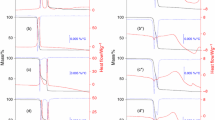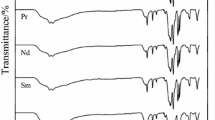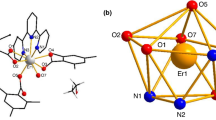Abstract
Solid-state [Ln(nal)3]·nH2O compounds, where Ln represents light trivalent lanthanide (La to Sm, except Pm), nal is nalidixate (C12H11N2O3), and n is the number of water molecules, were synthesized. Characterization and investigation were made by means of complexometry, elemental analysis, powder X-ray diffraction, Fourier transform infrared, near infrared (NIR) and diffuse reflectance spectroscopies, simultaneous thermogravimetry and differential thermal analysis, and differential scanning calorimetry. The dehydration process occurs in a single step up to 453 K. The final temperature of dehydration decreases from Pr(III) to Sm(III), and the thermal stability of anhydrous compounds increases from La(III) to Sm(III) (except Ce), and these behaviors are related to the decrease in the ionic radius of the lanthanide ion. The thermal decomposition of the anhydrous compounds occurs in three, four, or five consecutive steps, with formation of the respective oxides CeO2, Pr6O11, and Ln2O3 (Ln = La, Nd, and Sm) as final residues. The results also provide information concerning the composition and thermal behavior of these compounds. Spectroscopic studies in the UV–Vis and NIR regions provide information about the characteristics 4f–4f transitions for the Pr(III), Nd(III), and Sm(III) compounds, as well as the NIR region characteristic overtone and combination bands of the compounds.




Similar content being viewed by others
References
Zong GC, Ren N, Zhang JJ, Qi XX, Gao J. Lanthanide complexes with 3-bromine-4-methyl benzoic acid and 1,10-phenanthroline: synthesis, crystal structures, thermal properties and bacteriostatic activities. J Therm Anal Calorim. 2016;123:105–16.
Martinez-Gomez NC, Vu HN, Skovran E. Lanthanide chemistry: from coordination in chemical complexes shaping our technology to coordination in enzymes shaping bacterial metabolism. Inorg Chem. 2016;55:10083–9.
Wen H-R, Dong P-P, Liang F-Y, Liu S-J, Xie X-R, Tang Y-Z. A family of 2D lanthanide complexes based on flexible thiodiacetic acid with magnetocaloric or ferromagnetic properties. Inorg Chim Acta. 2017;455:190–6.
Wang W-M, Guan X-F, Liu X-D, Fang M, Zhang C-F, Fang M, et al. Two Gd2 compounds constructed by 8-hydroxyquinoline Schiff base ligands: synthesis, structure, and magnetic refrigeration. Inorg Chem Commun. 2017;79:8–11.
Liu F, Huang H, Gao W, Zhang X, Liu J-P. 3D Ln-MOFs containing pentanuclear clusters exhibiting magnetic refrigeration and slow magnetic relaxation. CrystEngComm. 2017;19:3660–5.
Gao C, Hou G, Zuo D, Jiang W, Yu Y, Ma D-S, et al. Syntheses, crystal structures, magnetisms and luminescences of two series of lanthanide coordination polymers based on tricarboxylic ligand. ChemistrySelect. 2017;2:1111–6.
Evstifeev IS, Efimov NN, Varaksina EA, Taydakov IV, Mironov VS, Dobrokhotova ZV, et al. Thermostable 1D lanthanide 4-phenylbenzoate polymers [Ln(4-phbz)3]n (Ln = Sm, Eu, Gd, Tb, Dy, Ho) with isolated metal chains: synthesis, structure, luminescence, and magnetic properties. Eur J Inorg Chem. 2017;2017:2892–904.
Ghosh S, Abbas Z, Dasari S, Patra AK. Luminescent Eu3+ and Tb3+ complexes of 4-aminophenyl terpyridine (ptpy): photophysical aspects, DNA and serum protein binding properties. J Lumin. 2017;187:46–52.
Akhtar MN, Chen Y-C, AlDamen MA, Tong M-L. 3D oxalato-bridged lanthanide (III) MOFs with magnetocaloric, magnetic and photoluminescence properties. Dalton Trans. 2017;46:116–24.
Wu J, Jin C, Zhang D-H, Ren N, Zhang J. A series of lanthanide complexes with 2,3-dichlorobenzoic acid and 2,2:6′,2″-terpyridine: crystal structures, spectroscopic and thermal properties. Thermochim Acta. 2015;620:28–35.
Qi X-X, Wu J-C, Ren N, Zhao C-L, Zhang J-J, Zong G-C, et al. Novel lanthanide complexes constructed from 3, 4-dimethoxybenzoic acid: crystal structures, spectrum and thermochemical properties. Thermochim Acta. 2015;615:1–7.
Huo J-X, Wang Y, Zhang D-H, Ren N, Zhang J-J. Syntheses, characterization, luminescence, and thermal decomposition mechanism of four lanthanide complexes with 4-ethylbenzoic acid and terpyridine. J Therm Anal Calorim. 2016;124:1575–85.
Wang G-T, Zhang J-C, Tang Z-Y, Zhou H-T, Zhang L, Yang R-W, et al. Synthesis, structures, luminescence and magnetism of nine lanthanide complexes with three-dimensional frameworks constructed from 2-(pyridyl-N-oxide)methylphosphonic acid and oxalic acid. CrystEngComm. 2016;18:2437–45.
Singh K, Srivastava P, Patra AK. Binding interactions with biological targets and DNA photocleavage activity of Pr(III) and Nd(III) complexes of dipyridoquinoxaline. Inorg Chim Acta. 2016;451:73–81.
Sarkar T, Banerjee S, Mukherjee S, Hussain A. Mitochondrial selectivity and remarkable photocytotoxicity of a ferrocenyl neodymium(III) complex of terpyridine and curcumin in cancer cells. Dalton Trans. 2016;45:6424–38.
Cotton FA, Wilkinson G. Advanced inorganic chemistry—a comprehensive text. 5th ed. New York: Wiley; 1988.
Campos FX, Nascimento ALCS, Colman TAD, Gálico DA, Carvalho ACS, Caires FJ, et al. Thermal behavior, spectroscopic studies and free radical scavenging potential of some mefenamate trivalent lanthanides (Sm, Eu, Gd, Tb and Dy). Thermochim Acta. 2017;651:73–82.
Campos FX, Soares MRS, Terezo AJ, Siqueira AB. Synthesis, characterization, and antioxidant evaluation of solid-state mefenamates of some bivalent metals. J Therm Anal Calorim. 2014;115:167–76.
Gálico DA, Lahoud MG, Davolos MR, Frem RCG, Fraga-Silva TFC, Venturini J, et al. Spectroscopic, luminescence and in vitro biological studies of solid ketoprofen of heavier trivalent lanthanides and yttrium(III). J Inorg Biochem. 2014;140:160–6.
Binil PS, Anoop MR, Jisha KR, Suma S, Sudarsanakumar MR. Synthesis, spectral characterization, thermal and biological studies of lanthanide(III) complexes of oxyphenbutazone. J Rare Earths. 2014;32:43–51.
Lin J, Xu X, Zhou W, Yu L, Wang Q. Easy assembly of visible light excited lanthanide containing edifices and structural origin. Dyes Pigments. 2015;119:56–61.
Zhou X, Zhao X, Wang Y, Wu B, Shen J, Li L, et al. Eu(III) and Tb(III) complexes with the nonsteroidal anti-inflammatory drug carprofen: synthesis, crystal structure, and photophysical properties. Inorg Chem. 2014;53:12275–82.
Singha S, Ahn K. Detection of ciprofloxacin in urine through sensitized lanthanide luminescence. Sensors. 2016;16:2065.
Kostova I, Momekov G, Tzanova T, Karaivanova M. Synthesis, characterization, and cytotoxic activity of new lanthanum(III) complexes of bis-coumarins. Bioinorg Chem Appl. 2006;2006:1–9.
Kostova I, Traykova M, Rastogi VK. New lanthanide complexes with antioxidant activity. Med Chem (Los Angeles). 2008;4:371–8.
Chen ZN, Deng RW, Wu JG. Synthesis, characterization, and antiinflammatory activity of naproxen complexes with rare earth (III). J Inorg Biochem. 1992;47:81–7.
Refat MS, Al-Maydama HMA, Al-Azab FM, Amin RR, Jamil YMS. Synthesis, thermal and spectroscopic behaviors of metal-drug complexes: La(III), Ce(III), Sm(III) and Y(III) amoxicillin trihydrate antibiotic drug complexes. Spectrochim Acta Part A. 2014;128:427–46.
Aggarwal N, Kumar R, Dureja P, Khurana JM. Synthesis, antimicrobial evaluation and QSAR analysis of novel nalidixic acid based 1,2,4-triazole derivatives. Eur J Med Chem. 2011;46:4089–99.
Uivarosi V. Metal complexes of quinolone antibiotics and their applications: an update. Molecules. 2013;18:11153–97.
Sekhon BS, Gandhi L. Synthesis and characterization of metal complexes of some antibacterial drugs. Int J Chemtech Res. 2010;2:286–8.
Psomas G, Kessissoglou DP. Quinolones and non-steroidal anti-inflammatory drugs interacting with copper(II), nickel(II), cobalt(II) and zinc(II): structural features, biological evaluation and perspectives. Dalton Trans. 2013;42:6252–76.
Eliseeva SV, Liasotkyi VS, Golovach IP, Doga PG, Antonovich VP, Petoud S, et al. Exploring the ability of the nalidixate to sensitize visible and near-infrared emitting lanthanide(III) cations. Methods Appl Fluoresc. 2017;5:14002.
Ionashiro M, Graner CAF, Netto JZ, Zuanon-Netto J. Titulação complexométrica de lantanídeos e ítrio. Eclética Química. 1983;8:29–32.
Flaschka HA. EDTA titrations: an introduction to theory and practice. 2nd ed. Oxford: Pergamon Press; 1964.
Lahoud MG, Frem RCG, Gálico DA, Bannach G, Nolasco MM, Ferreira RAS, Carlos LD. Intriguing light-emission features of ketoprofen-based Eu(III) adduct due to a strong electron–phonon coupling. J Lumin. 2016;170:357–63.
Gálico DA, Fraga-Silva TFC, Venturini J, Bannach G. Thermal, spectroscopic and in vitro biological studies of the lanthanum complex of naproxen. Thermochim Acta. 2016;644:43–9.
D’Assunção LM, Giolito I, Ionashiro M. Thermal decomposition of the hydrated basic carbonates of lanthanides and yttrium. Thermochim Acta. 1989;137:319–30.
Miyano MH, Melios CB, Ribeiro CA, Redigolo H, Ionashiro M. The preparation and thermal decomposition of solid state compounds of 4-dimethylaminobenzylidenepyruvate and trivalent lanthanides and yttrium. Thermochim Acta. 1993;221:53–62.
Oliveira LCS, Melios CB, Crespi MS, Ribeiro CA, Ionashiro M. Preparation and thermal decomposition of solid state compounds of 4-methoxybenzylidenepyruvate and trivalent lanthanides and yttrium. Thermochim Acta. 1993;219:215–24.
Daiguebonne C, Kerbellec N, Guillou O, Bünzli J-C, Gumy F, Catala L, et al. Structural and luminescent properties of micro- and nanosized particles of lanthanide terephthalate coordination polymers. Inorg Chem. 2008;47:3700–8.
Matias FRM, da Silva VMF, Nunes RS. Luiz JM. Synthesis, characterization and thermal behavior of some trivalent lanthanide 4-amino-benzenesulfonate salts. J Therm Anal Calorim. 2017;130:2185–90.
Bannach G, Schnitzler E, Treu-Filho O, Utuni VHS, Ionashiro M. Synthesis, characterization and thermal studies on solid compounds of 2-chlorobenzylidenepyruvate of heavier trivalent lanthanides and yttrium(III). J Therm Anal Calorim. 2006;83:233–40.
Bannach G, de Siqueira AB, Ionashiro EY, Rodrigues EC, Ionashiro M. Solid-state compounds of 2-chlorobenzylidenepyruvate with some bivalent metal ions: synthesis, characterization and thermal behaviour. J Therm Anal Calorim. 2007;90:873–9.
Zaky M, El-Sayed MY, El-Megharbel SM, Abo Taleb S, Refat MS. Complexes of nalidixic acid with some vital metal ions: synthesis, chemical structure elucidation, and antimicrobial evaluation. Russ J Gen Chem. 2013;83:2488–501.
Debnath A, Mogha NK, Masram DT. Metal complex of the first-generation quinolone antimicrobial drug nalidixic acid: structure and its biological evaluation. Appl Biochem Biotechnol. 2015;175:2659–67.
Sutton CCR, Da Silva G, Franks GV. Modeling the IR spectra of aqueous metal carboxylate complexes: correlation between bonding geometry and stretching mode wavenumber shifts. Chem A Eur J. 2015;21:6801–5.
Deacon GB, Huber F, Phillips RJ. Diagnosis of the nature of carboxylate coordination from the direction of shifts of carbonoxygen stretching frequencies. Inorg Chim Acta. 1985;104:41–5.
Deacon GB, Phillips RJ. Relationships between the carbon-oxygen stretching frequencies of carboxylato complexes and the type of carboxylate coordination. Coord Chem Rev. 1980;33:227–50.
Sastri VS, Bünzli J-CG, Rao VR, Rayudu GVS, Perumareddi JR. Spectroscopy of lanthanide complexes. In: Modern aspects of rare earths and their complexes. Elsevier Science; 2003. p. 569–731.
Vogler A, Kunkely H. Excited state properties of lanthanide complexes: beyond ff states. Inorg Chim Acta. 2006;359:4130–8.
Acknowledgements
The authors thank PROPe—UNESP (Proc. 0109/008/13-PROPe/CDC), FAPESP (Proc. 2006/06951-3), CAPES, and CNPq (Proc. 472233/2008-4 and 150759/2009) for financial support. This research was supported by resources supplied by the Faculdade de Engenharia de Guaratinguetá (UNESP), Instituto de Química de Araraquara (UNESP), and a special thanks to GFQM-IQ for X ray diffraction measurements.
Author information
Authors and Affiliations
Corresponding author
Electronic supplementary material
Below is the link to the electronic supplementary material.
Rights and permissions
About this article
Cite this article
Dobies Návia, M.V., Alves Gálico, D., Junior Caires, F. et al. Synthesis, thermal behavior, and spectroscopic study of the solid nalidixate of selected light trivalent lanthanides. J Therm Anal Calorim 132, 1717–1727 (2018). https://doi.org/10.1007/s10973-018-7042-0
Received:
Accepted:
Published:
Issue Date:
DOI: https://doi.org/10.1007/s10973-018-7042-0




